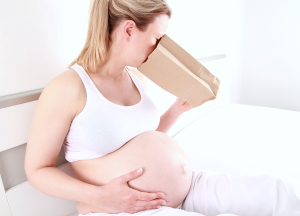High risk pregnancies
High risk pregnancies are associated with a number of situations that lead to higher than normal risks for a pregnancy. Most are only a higher risk for the fetus, but others are a higher risk for both the fetus and the mother. Some examples where hormonal disbalance contributes to risks in pregnancy are: gestational diabetes, thyroid disease, pituitary disease.
Hormones are essential for normal body function. This is even more important when a woman is pregnant. With diabetes, which is called gestational diabetes, there are higher risks for mother and child and these are discussed under this link.
Thyroid disease in the mother is not uncommon during pregnancy. If it occurs an endocrinologist and obstetrician should be consulted. Thyroid hormones cross the placental barrier. Treatments for the hyperthyroidism in the pregnant woman can cross into the fetus as well and cause hypothyroidism in the fetus. Radioactive therapy for pregnant patients has to be postponed until after the delivery and alternative medicine is given instead. For treatment of hypothyroidism thyroid replacement is given and blood tests of TSH are used to guide in the dosing.
Hyperemesis gravidarum is a condition that can develop in a small percentage of pregnant women where the initial period of being nauseous and occasionally vomiting turns into severe nausea and vomiting to the point where the woman has to be hospitalized, before she gets severely dehydrated. Fluids have to be replaced with intravenous electrolyte solutions and the woman needs to be closely monitored and kept resting in bed.
Maternal age
The age of a pregnant woman by itself carries a certain risk.
Generally speaking all of the factors taken together the time between 20 and 25 is ideal for getting babies. One factor is a statistically increased risk between age and chromosomal abnormalities.
A younger person usually adapts easier to the many emotional and hormonal changes that pregnancy and childbirth brings with it. The soft tissues in the pelvic and perineal areas including the joint between the sacral bone and the coccyx bone are more pliable below the age of 28 to 30 and medical problems such as hypertension and diabetes are less frequent as well. It is therefore not surprising that cesarean section rates are 10% higher for women above 35 compared to women below age 20 (Ref. 18, p.564).
Multiparity
Every obstetrician knows that when a woman carries her 6 th baby or even a higher number than that, this pregnancy is at a higher risk than her earlier pregnancies. There likely are a multiple number of reasons for his. She is older with every subsequent pregnancy and cardiac risks, hormonal risks (diabetes) as well as deteriorating kidney function with risks for hypertension are becoming more prominent. Genetic abnormalities of the fetus as well as higher twin rates with older age are also contributing risk factors. These pregnancies warrant closer monitoring.
Small fetus
There are a variety of reasons why a baby might be small. The second twin or one of the fetuses of triplets often is significantly smaller.
Often this may have been because of disadvantages of the placental blood distribution to the fetus. There can also be genetic reasons and intrauterine exposure to life style habits of the pregnant woman (smoking, cocaine addiction, alcohol abuse). Often these babies will be born at term, but they are more vulnerable to complications such as hypoglycemia (lack of glycogen stores), aspiration of meconium and lung problems subsequently. These babies require special care for a period of time.
Tubal pregnancy
This topic has been dealt with on another page under “ectopic pregnancy“.
References:
1. The Merck Manual, 7th edition, by M. H. Beers et al., Whitehouse Station, N.J., 1999. Chapter 235.
2. B. Sears: “Zone perfect meals in minutes”. Regan Books, Harper Collins, 1997.
3. Ryan: Kistner’s Gynecology & Women’s Health, 7th ed.,1999 Mosby, Inc.
4. The Merck Manual, 7th edition, by M. H. Beers et al., Whitehouse Station, N.J., 1999. Chapter 245.
5. AB Diekman et al. Am J Reprod Immunol 2000 Mar; 43(3): 134-143.
6. V Damianova et al. Akush Ginekol (Sofia) 1999; 38(2): 31-33.
7. Townsend: Sabiston Textbook of Surgery,16th ed.,2001, W. B. Saunders Company
8. Cotran: Robbins Pathologic Basis of Disease, 6th ed., 1999 W. B. Saunders Company
9. Rakel: Conn’s Current Therapy 2001, 53rd ed., W. B. Saunders Co.
10. Ruddy: Kelley’s Textbook of Rheumatology, 6th ed.,2001 W. B. Saunders Company
11. EC Janowsky et al. N Engl J Med Mar-2000; 342(11): 781-790.
12. Wilson: Williams Textbook of Endocrinology, 9th ed.,1998 W. B. Saunders Company
13. KS Pena et al. Am Fam Physician 2001; 63(9): 1763-1770.
14. LM Apantaku Am Fam Physician Aug 2000; 62(3): 596-602.
15. Noble: Textbook of Primary Care Medicine, 3rd ed., 2001 Mosby, Inc.
16. Goroll: Primary Care Medicine, 4th ed.,2000 Lippincott Williams & Wilkins
17. St. Paul’s Hosp. Contin. Educ. Conf. Nov. 2001,Vancouver/BC
18. Gabbe: Obstetrics – Normal and Problem Pregnancies, 3rd ed., 1996 Churchill Livingstone, Inc.
19. The Merck Manual, 7th edition, by M. H. Beers et al., Whitehouse Station, N.J., 1999. Chapter 251.
20. The Merck Manual, 7th edition, by M. H. Beers et al., Whitehouse Station, N.J., 1999. Chapter 250.
21. Ignaz P Semmelweiss: “Die Aetiologie, der Begriff und die Prophylaxis des Kindbettfiebers” (“Etiology, the Understanding and Prophylaxis of Childbed Fever”). Vienna (Austria), 1861.
22. Rosen: Emergency Medicine: Concepts and Clinical Practice, 4th ed., 1998 Mosby-Year Book, Inc.
23. Mandell: Principles and Practice of Infectious Diseases, 5th ed., 2000 Churchill Livingstone, Inc.
24. Horner NK et al. J Am Diet Assoc Nov-2000; 100(11): 1368-1380.
25. 19th Annual World Congress on Anti-Aging and Aesthetic Medicine in Las Vegas (December 8-10, 2011) Dr. Hertoghe lectured on “Premature aging caused by hormone deficiencies in utero”.







